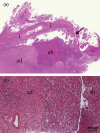Mycotic pseudoaneurysm of the ascending aorta caused by Escherichia coli
- PMID: 23065748
- PMCID: PMC3523620
- DOI: 10.1093/icvts/ivs376
Mycotic pseudoaneurysm of the ascending aorta caused by Escherichia coli
Abstract
An 81-year old woman with high fever and a history of hospital admission because of pyelonephritis 3 months previously was transferred to our hospital. Contrast-enhanced computed tomography revealed a mycotic pseudoaneurysm in the ascending aorta and a massive pericardial effusion. We resected the ascending aorta and the proximal part of the brachiocephalic artery and performed in situ revascularization with a prosthetic vascular graft. Bacterial examination proved that the causative micro-organism was Escherichia coli. The prosthetic graft was wrapped with a pedicled omentum following completion of the aortic reconstruction. Her postoperative course was uneventful. She was discharged from the hospital 1 month postoperatively.
Figures


Comment in
-
eComment. Antimicrobial vascular grafts in cardiac surgery.Interact Cardiovasc Thorac Surg. 2013 Jan;16(1):83. doi: 10.1093/icvts/ivs474. Interact Cardiovasc Thorac Surg. 2013. PMID: 23248212 Free PMC article. No abstract available.
-
eComment. Mycotic aortic aneurysms: a real challenge for the cardiac surgeon.Interact Cardiovasc Thorac Surg. 2013 Jan;16(1):83-4. doi: 10.1093/icvts/ivs505. Interact Cardiovasc Thorac Surg. 2013. PMID: 23248213 Free PMC article. No abstract available.
References
-
- Akashi Y, Ikehara Y, Yamamoto A, Suzuki N, Osada N, Matsumoto N, et al. Purulent pericarditis due to group B streptococcus and mycotic aneurysm of the ascending aorta: case report. Jpn Circ J. 2000;64:83–6. - PubMed
-
- Macedo TA, Stanson AW, Oderich GS, Johnson CM, Panneton JM, Tie ML. Infected aortic aneurysms: imaging findings. Radiology. 2004;231:250–7. - PubMed
-
- Chen IM, Chang HH, Hsu CP, Lai ST, Shih CC. Ten-year experience with surgical repair of mycotic aortic aneurysms. J Chin Med Assoc. 2005;68:265–71. - PubMed
-
- Kuniyoshi Y, Koja K, Miyagi K, Uezu T, Yamashiro S, Arakaki K. Graft for mycotic thoracic aortic aneurysm: omental wrapping to prevent infection. Asian Cardiovasc Thorac Ann. 2005;13:11–6. - PubMed
Publication types
MeSH terms
Substances
LinkOut - more resources
Full Text Sources
Medical

